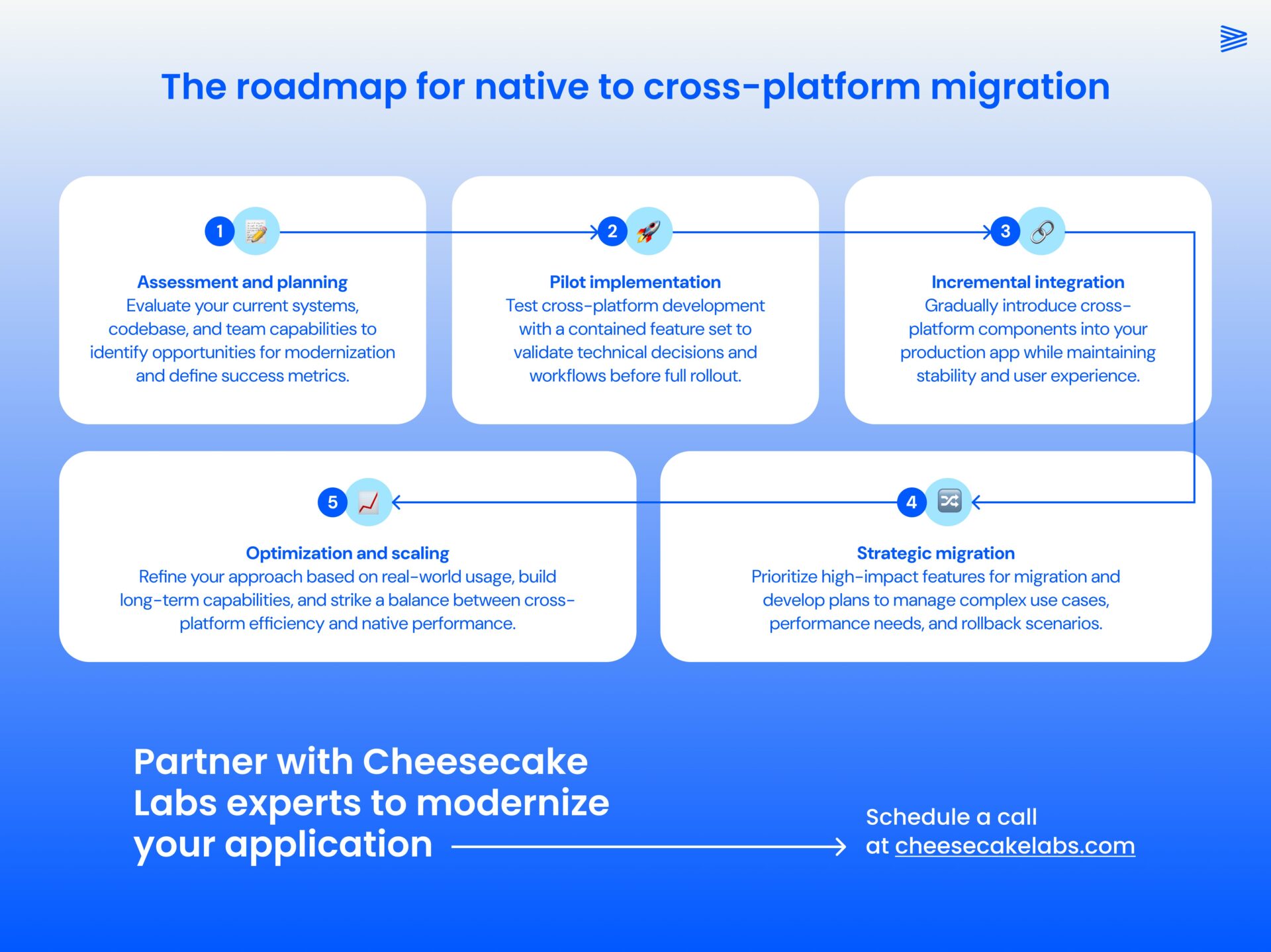AWS re:Invent 2025: The Year AI Agents Became Real for the Enterprise
Álan Monteiro | Dec 18, 2025

Mobile development has reached a critical inflection point. What began as an optional channel has evolved into the primary interface between businesses and their customers. This transformation has created operational and organizational challenges around managing multiple development teams, codebases, and release cycles, which require strategic solutions.
As mobile experiences become more central to business operations, many companies are discovering that outdated systems and fragmented development processes can’t keep up. That’s why application modernization (especially for legacy systems) is more than just a technical upgrade. It’s a strategic necessity.
That’s why more businesses are choosing to update and modernize legacy applications — the ones their customers use and the ones their teams use daily.
But once you’ve decided you need to modernize, how do you know where to start? That’s where an application modernization strategy comes in.
Keep reading to learn more about legacy application modernization strategies, why they’re so important, and what we recommend based on our experience working with our clients.
First things first, what is legacy application modernization?
Application modernization is the process of updating and transforming legacy software systems to align with current business requirements, user expectations, and technological standards.
Rather than replacing entire systems, this approach allows you to repurpose existing software by enhancing architecture, upgrading frameworks, and integrating modern cloud services into a more scalable application.
Legacy applications refer to outdated systems that, although still functional, often lack the scalability, performance, and security that modern businesses require.
Application modernization brings these systems up to date by enhancing their architecture, updating frameworks, and integrating cloud capabilities, without requiring a complete software refactor.
In some cases, legacy systems can persist far longer than expected. For example, parts of the U.S. air traffic control system still rely on 1990s-era technology, not because it’s ideal, but because replacement is complex and costly.
Businesses face similar dilemmas on a smaller scale — the cost and time required to update can be substantial, and it can be challenging to find the right team to carry out application modernization and migration services.
The longer modernization is delayed, the harder it becomes.
But why is software modernization so important? Why should you do it?
Ultimately, modernizing legacy applications is no longer a luxury for forward-thinking businesses. It’s essential for maintaining competitiveness, agility, and security in a rapidly changing digital landscape. Older software systems often suffer from poor scalability, high maintenance costs, security vulnerabilities, and integration challenges that limit business growth.
Here are some key reasons why an application modernization strategy is critical today:
These pressures are even more acute in today’s mobile-essential world, where customer expectations demand fast, seamless, and always-on digital experiences. Beyond the general need to keep older systems updated, relevant, and secure, businesses need to consider how they’re meeting the current technological moment and today’s consumer expectations.
Today’s businesses operate in a mobile-essential environment where applications serve as the primary revenue channel, customer engagement platform, and brand touchpoint.
Consider the broader trends:
For businesses, this means mobile has evolved from a complementary channel to often being the most critical touchpoint for customer engagement and revenue generation.
This evolution brings heightened expectations. Users demand native-quality experiences, seamless performance, and feature parity across platforms.
Meeting these expectations while managing development costs has become increasingly challenging with traditional approaches.
Many businesses have spent significant time and money creating native applications to serve their customers on both Android and iOS.
While native development delivers exceptional performance, maintaining separate iOS and Android codebases creates inefficiencies that cross-platform application modernization frameworks can address.
Here’s how cross-platform frameworks can help:
Not sure if native-to-cross-platform software modernization and migration is right for your business? Here’s a checklist with key indicators that suggest your organization could benefit from migrating native applications to cross-platform frameworks:
Organizations that check multiple boxes on this list often find that cross-platform migration delivers substantial improvements in development efficiency and business agility.
Still not sure? Learn more about why cross-platform migration works.
Thankfully, having a clear application modernization roadmap and strategy can make all the difference. Let’s examine the application modernization process in more detail.
At its core, an effective application modernization strategy focuses on improving performance, scalability, maintainability, and security, without losing the value embedded in legacy systems.
But application modernization isn’t one-size-fits-all. Depending on your business needs and desired outcomes, different approaches can be more effective. Common strategies include:
Choosing the right approach requires striking a balance between speed, cost, and long-term value. The following application modernization roadmap provides a practical example of how a business can effectively apply these strategies — specifically through migrating from native to cross-platform development — to modernize its applications.

As an example of a business application modernization approach, let’s examine how businesses can successfully migrate from native to cross-platform development by applying application modernization best practices.
Successfully migrating from native to cross-platform development requires addressing both technical and organizational challenges. This process involves careful planning, strategic implementation, and continuous refinement to ensure business value while maintaining application quality.
Here are the key application modernization steps for businesses looking to transition from native to cross-platform development.
The foundation of successful migration begins with a comprehensive evaluation of your current technical landscape and business requirements.
Start by conducting a thorough audit of your existing native codebase, identifying components based on their complexity, business criticality, and potential for cross-platform implementation.
Focus on understanding which parts of your application contain complex platform-specific integrations, such as camera functionality, payment processing, or biometric authentication, because these may require specialized handling during the migration process.
Create a detailed inventory of your current development resources, including team expertise, existing libraries, and third-party integrations. This assessment should reveal gaps between your current capabilities and the skills needed for cross-platform development.
Consider conducting a skills gap analysis to determine whether your team needs training in JavaScript frameworks, state management patterns, or cross-platform debugging techniques.
Establish clear success metrics for the migration process, including:
These metrics will guide decision-making throughout the migration and help demonstrate business value to stakeholders. Define both short-term objectives for individual phases and long-term goals for the complete migration process.
The pilot phase serves as your validation ground for cross-platform development within your specific organizational context.
Select pilot features based on three key criteria:
Consider selecting features such as user profile management, content browsing interfaces, or settings screens for your pilot implementation. These areas typically involve standard UI components and straightforward business logic while avoiding complex platform-specific integrations that could complicate initial adoption.
During pilot development, establish development workflows that will scale to larger implementations. This includes:
Document technical decisions, performance characteristics, and development productivity metrics throughout the pilot phase. Pay particular attention to areas where cross-platform implementation differs from native approaches, such as:
This documentation becomes invaluable for training additional team members and refining your migration strategy.
With pilot validation complete, begin systematic integration of cross-platform components into your production application. This phase requires careful architectural planning to ensure seamless interaction between native and cross-platform elements, while maintaining application stability and a high-quality user experience.
Develop clear integration patterns for common scenarios, including:
Establish consistent patterns for error handling, logging, and performance monitoring that work effectively in hybrid environments.
Focus on creating reusable component libraries that can accelerate future development while maintaining design consistency across platforms. These libraries should include both UI components and business logic modules that can be shared between different parts of your application and across multiple applications within your organization.
Implement comprehensive testing strategies that cover integration points between native and cross-platform components. This includes:
Based on insights from incremental integration, identify high-impact areas for broader migration efforts. Prioritize features that:
Consider the business impact of each migration decision, focusing on areas that will deliver the most value relative to implementation effort.
Develop migration strategies for complex features that require careful handling, such as those with extensive platform-specific customizations or critical performance requirements.
This may involve creating hybrid approaches where core business logic is moved to cross-platform implementation, while platform-specific optimizations remain in native code.
Establish rollback procedures for each migration effort to ensure that you can revert to native implementations if unexpected issues arise. This safety net enables more aggressive migration timelines while maintaining application stability and ensuring a high-quality user experience.
The final phase focuses on refining your cross-platform development approach based on real-world usage patterns and performance data. Analyze application performance metrics to identify optimization opportunities, particularly in areas where cross-platform implementation might introduce performance overhead compared to native alternatives.
Establish long-term maintenance strategies that strike a balance between the benefits of cross-platform development and the need for platform-specific optimizations.
This includes creating processes for evaluating when new features should use cross-platform approaches versus native implementations based on specific requirements and constraints.
Develop organizational capabilities for sustained success in cross-platform development. This involves:
The key to successful migration lies in treating this as an evolutionary process rather than a revolutionary change.
Each phase builds upon previous learnings while maintaining application stability and user experience throughout the transition.
React Native particularly excels in supporting this gradual approach, allowing organizations to integrate cross-platform components seamlessly into existing native applications while preserving the performance and user experience benefits of native development where they matter most.
Cross-platform migration is more than just a technical shift — it’s a strategic move that helps businesses unlock greater agility, scalability, and long-term value. In today’s mobile-essential environment, modernizing processes isn’t just about keeping up. It’s about building the foundation for future growth.
The application modernization benefits are clear: faster development cycles, lower maintenance costs, easier access to development talent, and more consistent user experiences across platforms. However, realizing those benefits requires a structured and practical approach.
That’s where a phased modernization strategy comes in. As outlined earlier in this guide, the most successful initiatives are gradual and data-driven, starting with small wins, validating technical decisions, and scaling intelligently.
Choosing the right application modernization tools, like React Native, allows you to preserve the performance advantages of native development while reaping the rewards of cross-platform efficiency.
At Cheesecake Labs, we have hands-on experience delivering application modernization and mobile app development services for companies of all sizes and industries. We’ve delivered enterprise app modernization projects across the fintech, pharmaceutical, and e-commerce sectors.
Our strength lies in balancing short-term operational needs with long-term performance, using tailored application modernization solutions that support real business outcomes.
If your organization is dealing with outdated mobile apps, inefficient infrastructure, or disconnected development workflows, Cheesecake Labs can help. We provide end-to-end application modernization services tailored to your team’s skills, your systems, and your business goals.
Our services include:

Whether you’re a mid-sized company looking to shift cumbersome native applications to a more streamlined cross-platform solution or an enterprise with ageing, complex digital systems, we’ll help you build an IT modernization strategy that drives growth without sacrificing stability.
Let Cheesecake Labs guide your next phase of digital transformation with proven expertise and scalable, future-ready technology.
Get in touch today to discuss your application modernization needs.

Guilherme is a Staff Engineer with 11 years of comprehensive experience in full-stack development, architectural design, and technical leadership. Specializing in end-to-end software solutions with deep expertise in React Native development since 2018, combining strong technical skills with strategic systemic vision to drive complex projects from conception to deployment. As an AWS Cloud Practitioner certified professional, brings both hands-on development experience and architectural thinking to deliver scalable, robust software solutions.


